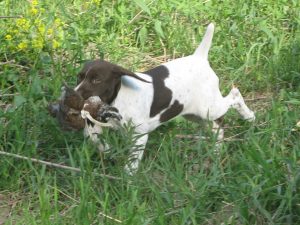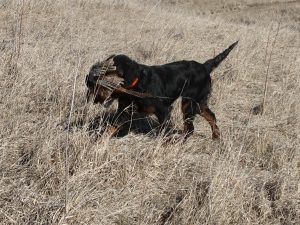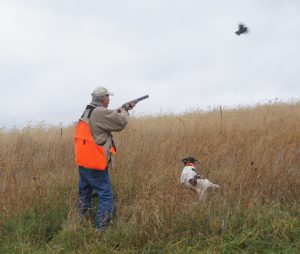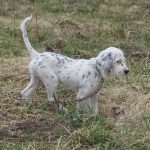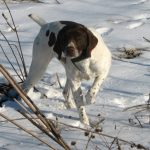POINTING DOG POINTERS: Problems in Developing the Started Dog – Retrieving
By Bob and Jody Iler
Let’s talk retrieving!
Is your young pointing dog retrieving? Or does he ignore the fallen bird and continue to hunt? If he retrieves, does he carry the bird like a delicate eggshell, with a soft mouth, occasionally dropping the bird? Or does he disembowel the bird before you have a chance to get it away from him? (We had a trainee pup one year, aptly named Chomp, that did just that.)
How important is retrieving to you?
For some, it is all about the stylish point, the shot, the flawless performance of being steady to wing and shot. For others, it’s important that their dogs retrieve the birds, no matter how flawless the performance before the kill. For a person whose intent is bagging his limit of birds afield with his canine partner, having a dog that marks the bird and runs out to retrieve it is crucial. And folks that compete with their dogs in field events will need their dogs to retrieve to hand.
We inform our clients at the outset that our started dog program includes getting pup as birdy as all get out, and developing pup to scent and hunt birds with gusto. We teach pup to handle reasonably well in the field as he also learns the basic yardwork commands of heel, whoa, and here (come). Finally, we introduce noise to the equation and develop pup to the gun in incremental stages as we continue bird work. At the end of the three-month program, pup should be hunting and finding birds, pointing, handling, and gun broke – ready to start his next level of education as he begins his first hunting season.
Inevitably, though, our client will always ask, “Why don’t you teach my pup to retrieve during this started dog program?”
Our short answer is that all of our pups get the opportunity to retrieve during field sessions in our program. If the pup is a natural retriever, it makes our job of developing this trait easier, using lots of positive reinforcement. Other pups, though, will show no interest in retrieving, and many will fall somewhere in the gray area in between. As with all of pup’s attributes, genetics surely play a role in a pup that is a natural retriever.
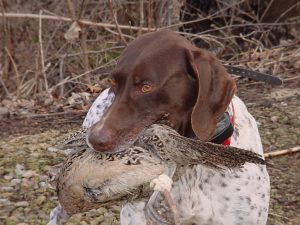
The trained retrieve program ensures reliable retrieves but isn’t for young dogs in their first season.
The only way to make sure that pup retrieves reliably, at all times, is to “force break” him – or, as we call it, teach him the “trained retrieve.” This is not training that is suitable for a young dog that hasn’t even been hunted a season. It requires time, plenty of patience, and expertise on the trainer’s part – and the young dog should have at least a season or two of hunting experience before this training is started. Additionally, the dog should be bird crazy and hunting with joy and abandon. We never want to teach our pup – or let him experience – anything that is negative in relation to birds, whenever possible.
For example, letting pup hunt with other more experienced dogs in order for him to “learn to retrieve” may have the opposite effect. He may feel overpowered and not even try to retrieve himself, if the other dog beats him to it. Sometimes this scenario can create hard feelings between dogs or instigate a fight for the bird. On the flip side, though, it won’t hurt and may help to let your pup watch another dog retrieve. Make sure your pup is on a lead and under control, and let him observe another dog point and retrieve. This “jealousy” method can sometimes help to get a young pup excited about retrieving.
And though this column isn’t about the e-collar, we offer the example of a friend of ours, who found out the hard way about misuse of the e-collar related to the retrieve. His very capable and experienced Shorthair was picking up birds, but then she would start to shake them vigorously. In order to stop that behavior, he used e-collar stimulation on her when she did this. The result? You guessed it! She quit picking up the bird at all!
We don’t worry about a pup retrieving during the first season, or even the second. We want the other important things to come together – we want our pup to be out there hunting the birdy objectives with a lot of drive, we want him to be pointing the bird, and we want him to learn to work as our partner in the field. If he shows natural retrieving ability, we certainly encourage it, with opportunities for the pup to retrieve and lots of praise if he does. Remember, our primary aim is to keep everything positive!
Sometimes our clients try to prepare their dogs to be good retrievers by having them chase and retrieve balls and dummies prior to field training. We’ve had lots of nice pups that will retrieve those items and then show no interest in picking up a bird. Like a pup’s inherent ability to point solidly, retrieving is also “built-in.” The natural retriever will head out and pick up that bird. He may not want to bring it back to you right away, and he may want to carry it around proudly for a while. He may drop it and pick it up again if he has a soft, tender mouth. These are all good things to encourage and praise. If, however, he mangles the bird when he picks it up, try to get to him right away and remove it. This fellow will be a candidate for the trained retrieve down the road, and hard mouth should be discouraged – using care not to turn the pup off of birds.
Some words of caution here – don’t overdo the retrieving at the start. Too much of a good thing can tire the pup and cause him to lose interest. Too many retrieves may work against developing a staunch point at this early stage as well. Keep retrieves to a minimum at first, to help pup to hold point with intensity and anticipate the occasional reward of a retrieve. Later on, this won’t matter nearly as much. Also, some birds are distasteful for some pups to pick up – doves will leave them with a mouthful of feathers, for example. They may also be reluctant to pick up woodcock or snipe. Refrain from using rooster pheasants in game preserve training sessions in the early season, to prevent pup from getting spurred by a crippled rooster, as this can turn him off of birds.
Young dogs tend not to mark the birds well until they have learned to watch closely after the shot. Give them a chance to get out and find the bird. If they have a good nose, they generally will find it, and over time will learn to mark the bird well.
Finally, give pup time before you decide he’s not a natural at retrieving. We’ve been happily surprised by some of our own young dogs that began to retrieve on their own after a season or two. Once they learn to love the birds and hunt, find, and point them for you – it follows naturally that they will often mark and find the bird after the shot. When they show interest in picking up birds, sweet talk and praise will often do wonders in helping them learn to bring the bird to you. Back up, walk the other way, gently clap your hands, and encourage the pup to hold the bird and bring it to you.
To retrieve or not to retrieve? As with all training, time, experience, and patience will help you find your answers!
Pointing Dog Pointers features monthly training tips by Bob and Jody Iler, who own Green Valley Kennels in Dubuque, Iowa. Bob and Jody have trained pointing dogs for over 35 years and have written many articles for Pointing Dog Journal.



